本日更新の2024年03月試験エンジンとPDF AZ-104テスト無料!
究極のガイド準備AZ-104正確なPDF解答
質問 # 102
You have an Azure Subscription named Subcription1.has
Subcription1 contains the virtual machines in the following table.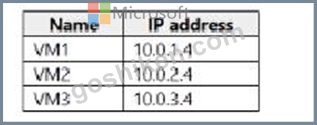
Subcription1 contains the virtual machines in the following table.
VM3 has multiple network, including a network adapter named NIC3, IP forwarding is enabled on NIC3. Routing is enabled on VM3.
You create a route table named RT1 that contains the routes in the following table.
You apply RT1 to subnet1 and Sybnet2.
For each of the following statements, select Yes if the statements is true. Otherwise, select No.
NOTE: Each correct selection is worth one point.
正解:
解説:
Reference:
https://docs.microsoft.com/en-us/azure/virtual-network/virtual-networks-udr-overview
https://www.quora.com/What-is-IP-forwarding
質問 # 103
Your network contains an Active Directory domain named adatum.com and an Azure Active Directory (Azure AD) tenant named adatum.onmicrosoft.com.
Adatum.com contains the user accounts in the following table.
Adatum.onmicrosoft.com contains the user accounts in the following table.
You need to implement Azure AD Connect. The solution must follow the principle of least privilege.
Which user accounts should you use? To answer, select the appropriate options in the answer area.
NOTE: Each correct selection is worth one point.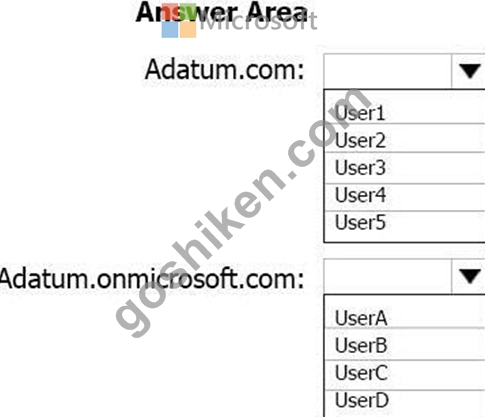
正解:
解説: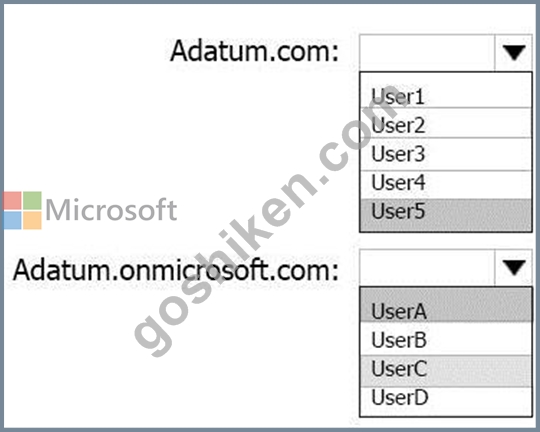
Box 1: User5
In Express settings, the installation wizard asks for the following:
AD DS Enterprise Administrator credentials
Azure AD Global Administrator credentials
The AD DS Enterprise Admin account is used to configure your on-premises Active Directory. These credentials are only used during the installation and are not used after the installation has completed. The Enterprise Admin, not the Domain Admin should make sure the permissions in Active Directory can be set in all domains.
Box 2: UserA
Azure AD Global Admin credentials credentials are only used during the installation and are not used after the installation has completed. It is used to create the Azure AD Connector account used for synchronizing changes to Azure AD. The account also enables sync as a feature in Azure AD.
References:
https://docs.microsoft.com/en-us/azure/active-directory/connect/active-directory-aadconnect-accounts-permissio
質問 # 104
Note: This question is part of a series of questions that present the same scenario. Each question in the series contains a unique solution that might meet the stated goals. Some question sets might have more than one correct solution, while others might not have a correct solution.
After you answer a question in this section, you will NOT be able to return to it. As a result, these questions will not appear in the review screen.
You have an Azure subscription named Subscription1. Subscription1 contains a resource group named RG1. RG1 contains resources that were deployed by using templates.
You need to view the date and time when the resources were created in RG1.
Solution: From the Subscriptions blade, you select the subscription, and then click Programmatic deployment.
Does this meet the goal?
- A. Yes
- B. No
正解:B
解説:
From the RG1 blade, click Deployments. You see a history of deployment for the resource group.
Reference:
https://docs.microsoft.com/en-us/azure/azure-resource-manager/templates/template-tutorial-create-first-template?tabs=azure-powershell Through activity logs, you can determine:
* what operations were taken on the resources in your subscription
* who started the operation
* when the operation occurred
* the status of the operation
* the values of other properties that might help you research the operation On the Azure portal menu, select Monitor, or search for and select Monitor from any page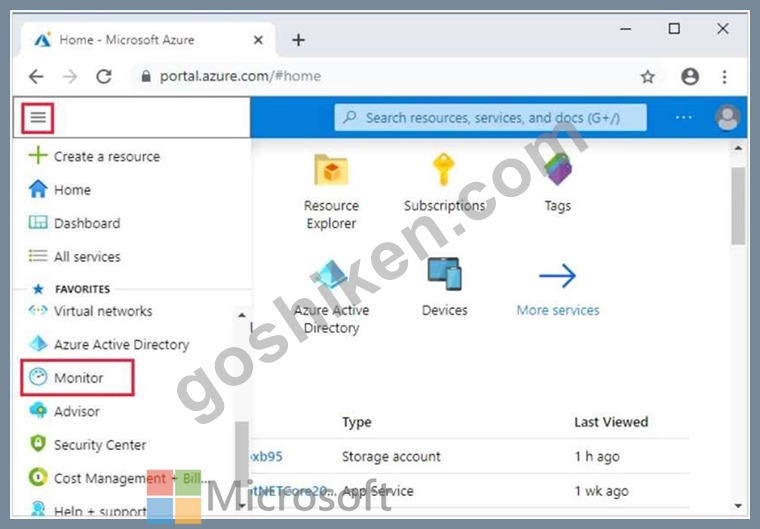
2. Select Activity Log.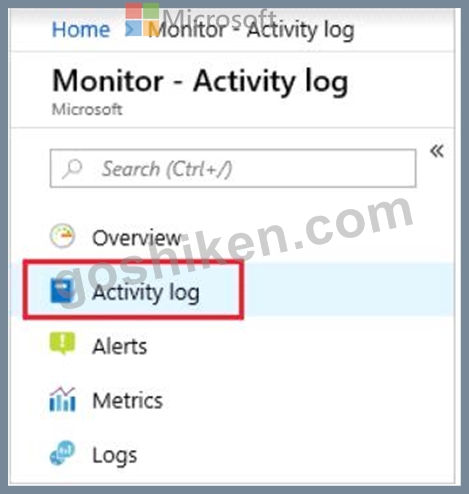
3. You see a summary of recent operations. A default set of filters is applied to the operations. Notice the information on the summary includes who started the action and when it happened.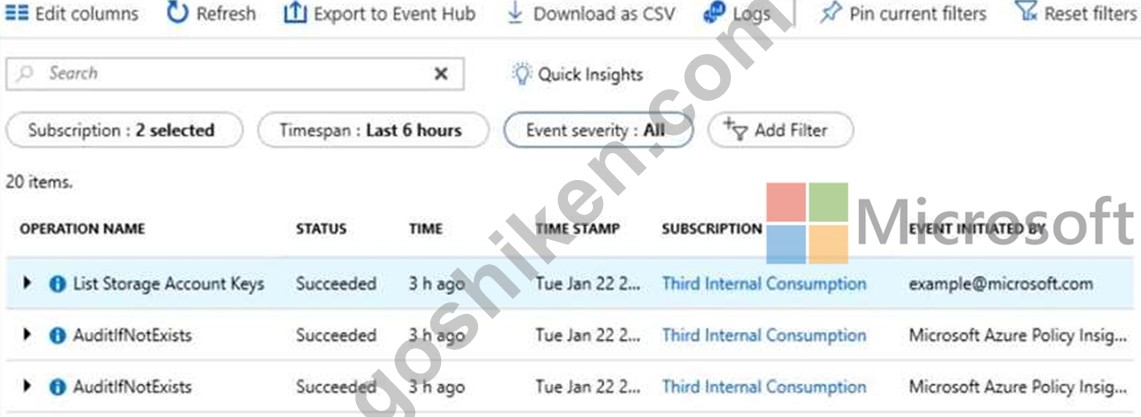
https://docs.microsoft.com/en-us/azure/azure-resource-manager/management/view-activity-logs
質問 # 105
You need to use Azure Automation State Configuration to manage the ongoing consistency of virtual machine configurations.
Which five actions should you perform in sequence? To answer, move the appropriate action from the list of actions to the answer area and arrange them in the correct order.
NOTE: More than one order of answer choices is correct. You will receive credit for any of the correct orders you select.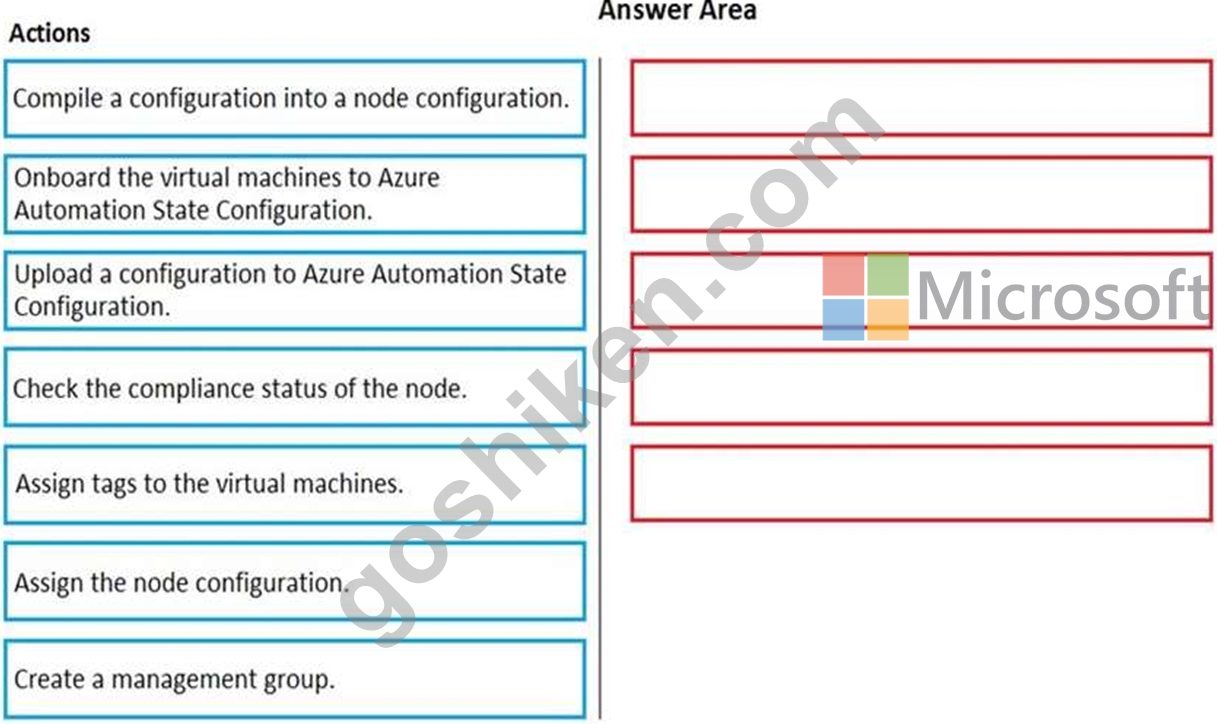
正解:
解説: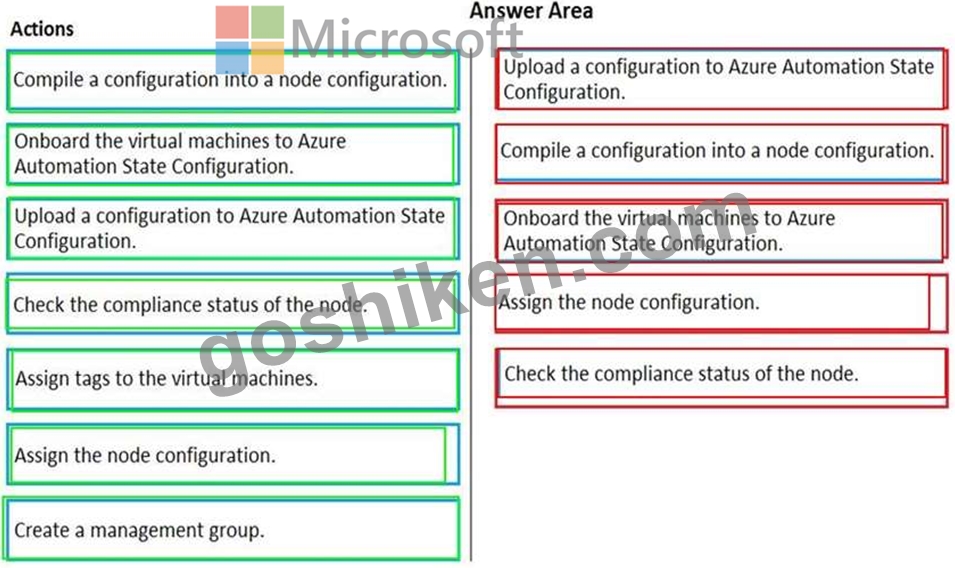
Reference:
https://docs.microsoft.com/en-us/azure/automation/automation-dsc-getting-started
質問 # 106
You have an Azure web app named WebApp1.
You need to provide developers with a copy of WebApp1 that they can modify without affecting the production WebApp1. When the developers finish testing their changes, you must be able to switch the current line version of WebApp1 to the new version.
Which command should you run prepare the environment? To answer, select the appropriate options in the answer area.
NOTE: Each correct selection is worth one point.
正解:
解説:
Reference:
https://docs.microsoft.com/en-us/powershell/module/azurerm.websites/new-azurermwebappslot
質問 # 107
You have an Azure subscription that contains an Azure Availability Set named WEBPROD-AS-USE2 as shown in the following exhibit.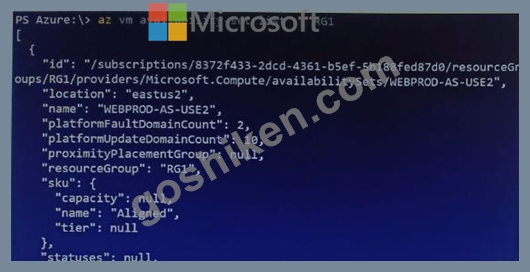

You add 14 virtual machines to WEBPROD-AS-USE2.
Use the drop-down menus to select the answer choice that completes each statement based on the information presented in the graphic.
NOTE: Each correct selection is worth one point.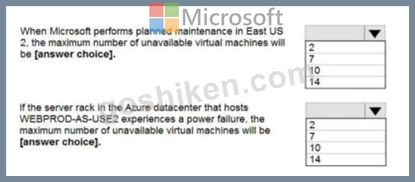
正解:
解説:
Explanation
Box 1: 2
There are 10 update domains. The 14 VMs are shared across the 10 update domains so four update domains will have two VMs and six update domains will have one VM. Only one update domain is rebooted at a time.
Therefore, a maximum of two VMs will be offline.
Box 2: 7
There are 2 fault domains. The 14 VMs are shared across the 2 fault domains, so 7 VMs in each fault domain.
A rack failure will affect one fault domain so 7 VMs will be offline.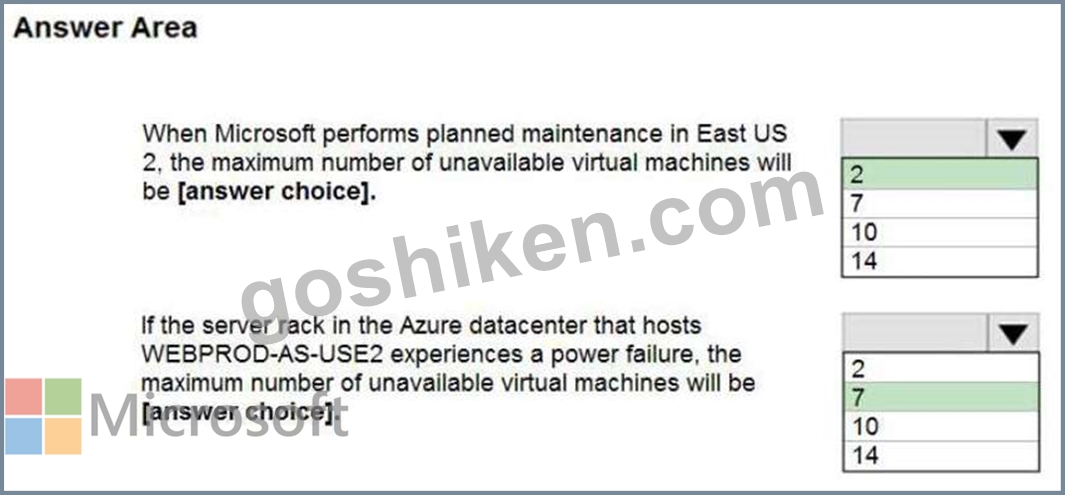
Reference:
https://docs.microsoft.com/en-us/azure/virtual-machines/windows/manage-availability
質問 # 108
You have an Azure Service Bus.
You create a queue named Queue1. Queue1 is configured as shown in the following exhibit.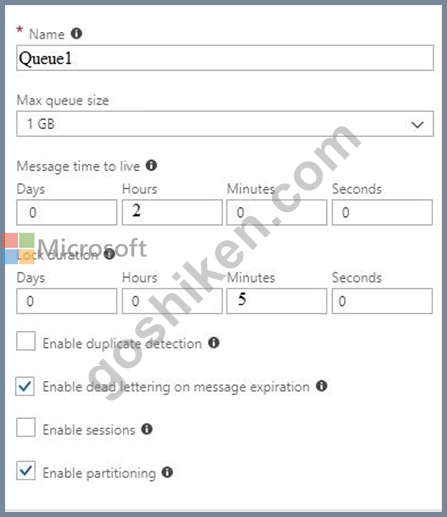
Use the drop-down menus to select the answer choice that completes each statement based on the information presented in the graphic.
NOTE: Each correct selection is worth one point.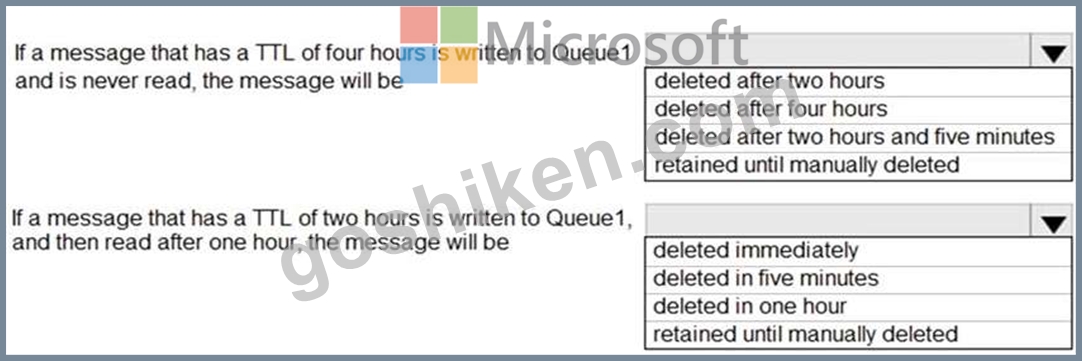
正解:
解説: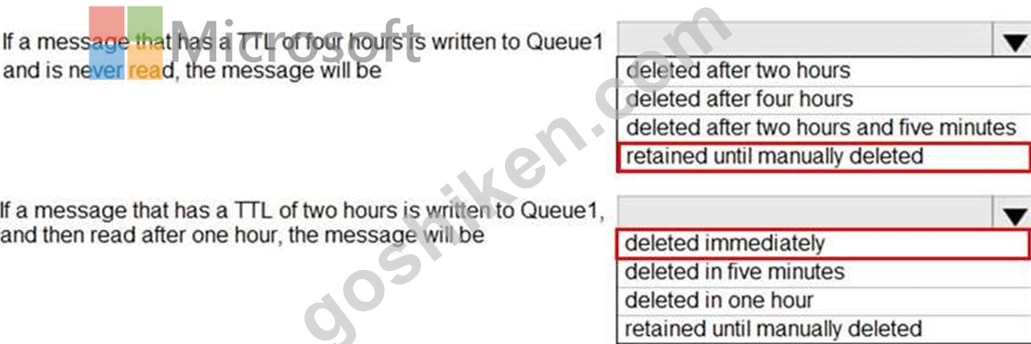
Reference:
https://docs.microsoft.com/en-us/azure/service-bus-messaging/message-expiration
https://docs.microsoft.com/en-us/azure/service-bus-messaging/message-transfers-locks-settlement
質問 # 109
You have an Azure subscription that contains the resources shown in the following table.
NSG1 is configured as shown in the following exhibit.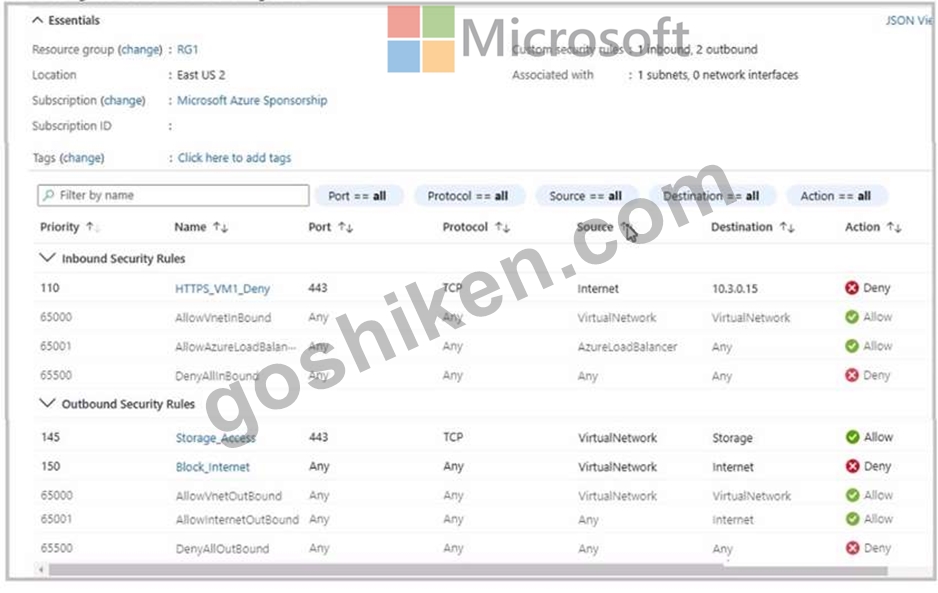
For each of the following statements, select Yes if the statement is true. Otherwise, select No.
NOTE: Each correct selection is worth one point.
正解:
解説:
質問 # 110
You need to create an Azure Storage account that meets the following requirements:
* Minimizes costs
* Supports hot, cool, and archive blob tiers
* Provides fault tolerance if a disaster affects the Azure region where the account resides
How should you complete the command? To answer, select the appropriate options in the answer area. NOTE: Each correct selection is worth one point
正解:
解説:
Explanation:
Box 1: StorageV2
You may only tier your object storage data to hot, cool, or archive in Blob storage and General Purpose v2 (GPv2) accounts. General Purpose v1 (GPv1) accounts do not support tiering.
General-purpose v2 accounts deliver the lowest per-gigabyte capacity prices for Azure Storage, as well as industry-competitive transaction prices.
Box 2: Standard_GRS
Geo-redundant storage (GRS): Cross-regional replication to protect against region-wide unavailability.
Incorrect Answers:
Locally-redundant storage (LRS): A simple, low-cost replication strategy. Data is replicated within a single storage scale unit.
Read-access geo-redundant storage (RA-GRS): Cross-regional replication with read access to the replica. RA-GRS provides read-only access to the data in the secondary location, in addition to geo-replication across two regions, but is more expensive compared to GRS.
References:
https://docs.microsoft.com/en-us/azure/storage/common/storage-redundancy-grs
https://docs.microsoft.com/en-us/azure/storage/blobs/storage-blob-storage-tiers
質問 # 111
You have an Azure subscription that contains the virtual machines shown in the following table.
VM1 and VM2 use public IP addresses. From Windows Server 2019 on VM1 and VM2, you allow inbound Remote Desktop connections.
Subnet1 and Subnet2 are in a virtual network named VNET1.
The subscription contains two network security groups (NSGs) named NSG1 and NSG2. NSG1 uses only the default rules.
NSG2 uses the default and the following custom incoming rule:
Priority: 100
Name: Rule1
Port: 3389
Protocol: TCP
Source: Any
Destination: Any
Action: Allow
NSG1 connects to Subnet1. NSG2 connects to the network interface of VM2.
For each of the following statements, select Yes if the statement is true. Otherwise, select No.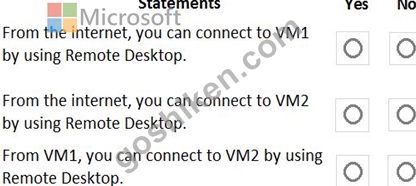
正解:
解説: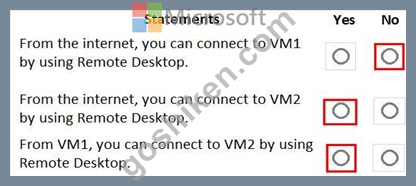
Reference:
https://docs.microsoft.com/en-us/azure/virtual-machines/troubleshooting/troubleshoot-rdp-connection
質問 # 112
You have an azure subscription that contain a virtual named VNet1. VNet1. contains four subnets named Gatesway, perimeter, NVA, and production.
The NVA contain two network virtual appliance (NVAs) that will network traffic inspection between the perimeter subnet and the production subnet.
You need to implement an Azure load balancer for the NVAs. The solution must meet the following requirements:
The NVAs must run in an active-active configuration that uses automatic failover.
The NVA must load balance traffic to two services on the Production subnet. The services have different IP addresses
Which three actions should you perform? Each correct answer presents parts of the solution.
NOTE: Each correct selection is worth one point.
- A. Add a frontend IP configuration, two backend pools, and a health prob.
- B. Deploy a basic load balancer.
- C. Deploy a standard load balancer.
- D. Add two load balancing rules that have HA Ports and Floating IP enabled.
- E. Add two load balancing rules that have HA Ports enabled and Floating IP disabled.
- F. Add a frontend IP configuration, a backend pool, and a health probe.
正解:A、C、D
解説:
A standard load balancer is required for the HA ports.
-Two backend pools are needed as there are two services with different IP addresses.
-Floating IP rule is used where backend ports are reused.
Incorrect Answers:
F: HA Ports are not available for the basic load balancer.
Reference:
https://docs.microsoft.com/en-us/azure/load-balancer/load-balancer-standard-overview
https://docs.microsoft.com/en-us/azure/load-balancer/load-balancer-multivip-overview
The following diagram presents a hub-and-spoke virtual network deployment. The spokes force-tunnel their traffic to the hub virtual network and through the NVA, before leaving the trusted space. The NVAs are behind an internal Standard Load Balancer with an HA ports configuration. All traffic can be processed and forwarded accordingly. When configured as show in the following diagram, an HA Ports load-balancing rule additionally provides flow symmetry for ingress and egress traffic.
https://docs.microsoft.com/en-us/azure/load-balancer/load-balancer-overview
https://docs.microsoft.com/en-us/azure/load-balancer/load-balancer-multivip-overview
https://docs.microsoft.com/en-us/azure/load-balancer/load-balancer-ha-ports-overview#a-single-floating-ip-direct-server-return-ha-ports-configuration-on-an-internal-standard-load-balancer
質問 # 113
You have an Azure App Service app named WebApp1 that contains two folders named Folder1 and Folder2.
You need to configure a daily backup of WebApp1. The solution must ensure that Folder2 is excluded from the backup.
What should you create first and what should you use to exclude Fokier2? To answer, select the appropriate options in the answer area.
NOTE: Each correct selection is worth one point.
正解:
解説:
質問 # 114
You have peering configured as shown in the following exhibit.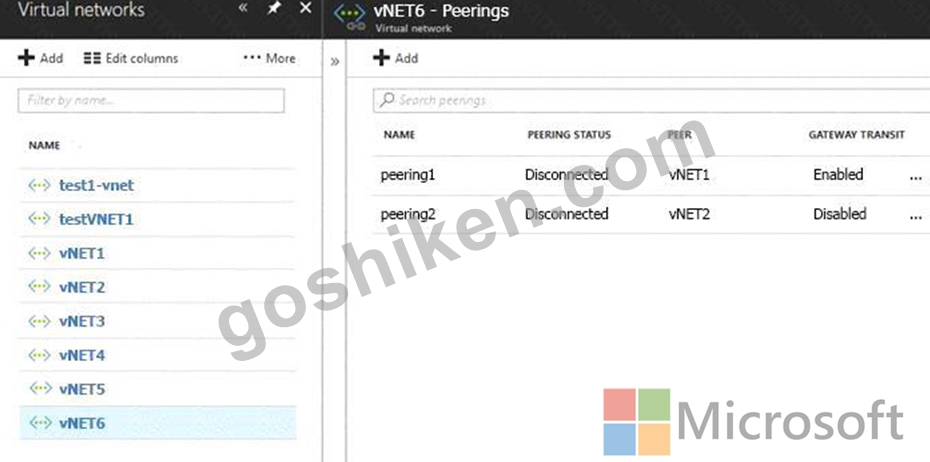
Use the drop-down menus to select the answer choice that completes each statement based on the information presented in the graphic.
NOTE: Each correct selection is worth one point.
正解:
解説:
Explanation
Box 1: vNET6 only
Box 2: Modify the address space
The virtual networks you peer must have non-overlapping IP address spaces.
References:
https://docs.microsoft.com/en-us/azure/virtual-network/virtual-network-manage-peering#requirements-and-const
質問 # 115
You need to ensure that you can grant Group4 Azure RBAC read-only permissions to all the A2ure file shares.
What should you do?
- A. On storagel and storage4, change the Account kind type to StorageV2 (general purpose v2).
- B. Create a shared access signature (SAS) for storagel, storage2, and storage4.
- C. Recreate storage2 and set Hierarchical namespace to Enabled.
- D. On storage2, enable identity-based access for the file shares.
正解:A
質問 # 116
Your company has offices in New York and Los Angeles.
You have an Azure subscription that contains an Azure virtual network named VNet1. Each office has a site-to-site VPN connection to VNet1.
Each network uses the address spaces shown in the following table.
You need to ensure that all Internet-bound traffic from VNet1 is routed through the New York office.
What should you do? To answer, select the appropriate options in the answer area.
NOTE: Each correct selection is worth one point.
正解:
解説:
Reference:
https://docs.microsoft.com/en-us/powershell/module/azurerm.network/set-azurermvirtualnetworkgatewaydefaultsite?view=azurermps-6.13.0
https://docs.microsoft.com/en-us/azure/vpn-gateway/vpn-gateway-forced-tunneling-rm
質問 # 117
You have an Azure subscription that contains the resource groups shown in the following table.
RG1 contains the resources shown in the following table.

正解:
解説:
質問 # 118
You have an Azure subscription that contains a virtual machine named VM1.
To VM1, you plan to add a 1-TB data disk that meets the following requirements:
* Provides data resiliency in the event of a datacenter outage.
* Provides the lowest latency and the highest performance.
* Ensures that no data loss occurs if a host fails.
You need to recommend which type of storage and host caching to configure for the new data disk.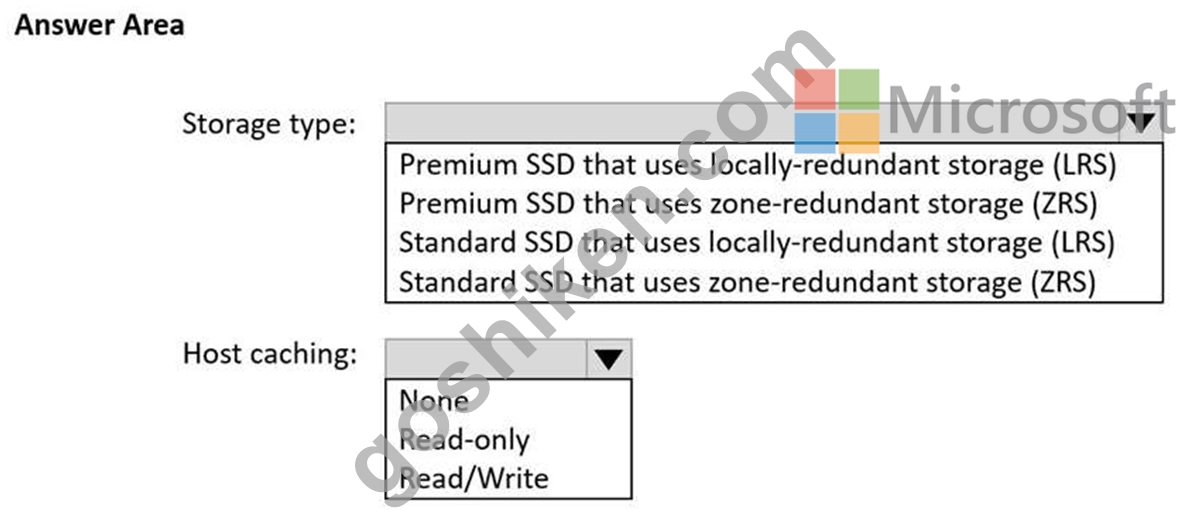
正解:
解説: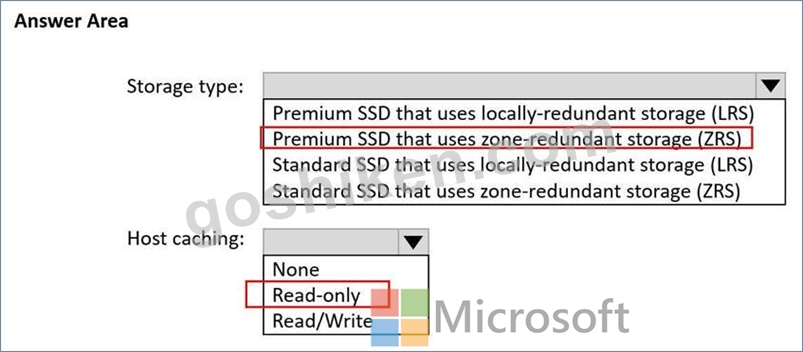
質問 # 119
You have an Azure subscription named Subscription1 that contains the storage accounts shown in the following table:
You plan to use the Azure Import/Export service to export data from Subscription1.
You need to identify which storage account can be used to export the data.
What should you identify?
- A. storage1
- B. storage3
- C. storage4
- D. storage2
正解:C
解説:
Explanation
Azure Import/Export service supports the following of storage accounts:
* Standard General Purpose v2 storage accounts (recommended for most scenarios)
* Blob Storage accounts
* General Purpose v1 storage accounts (both Classic or Azure Resource Manager deployments), Azure Import/Export service supports the following storage types:
* Import supports Azure Blob storage and Azure File storage
* Export supports Azure Blob storage
Reference:
https://docs.microsoft.com/en-us/azure/storage/common/storage-import-export-requirements
質問 # 120
You have an Azure virtual machine mat runs Windows Server 2019 and has the following configurations:
* Name:VM1
* Location: Welt US
* Connected to: VNfT1
* Private IP address: 10.1.0.4
* Public IP address: 52 18685.63
* DNS suffix m Windows Server.Adatum.com
You create the Azure DNS zones shown in the following table.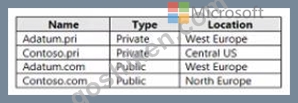

正解:
解説:
Explanation
質問 # 121
You need to identify the storage requirements for Contoso.
For each of the following statements, select Yes if the statement is true. Otherwise, select No.
NOTE: Each correct selection is worth one point.
正解:
解説:
Explanation:
Statement 1: Yes
Contoso is moving the existing product blueprint files to Azure Blob storage which will ensure that the blueprint files are stored in the archive storage tier.
Use unmanaged standard storage for the hard disks of the virtual machines. We use Page Blobs for these.
Statement 2: No
Azure Table storage stores large amounts of structured data. The service is a NoSQL datastore which accepts authenticated calls from inside and outside the Azure cloud. Azure tables are ideal for storing structured, non-relational data. Common uses of Table storage include:
1. Storing TBs of structured data capable of serving web scale applications
2. Storing datasets that don't require complex joins, foreign keys, or stored procedures and can be denormalized for fast access
3. Quickly querying data using a clustered index
4. Accessing data using the OData protocol and LINQ queries with WCF Data Service .NET Libraries Statement 3: No File Storage can be used if your business use case needs to deal mostly with standard File extensions like *.docx, *.png and *.bak then you should probably go with this storage option.
Reference:
https://docs.microsoft.com/en-us/azure/machine-learning/team-data-science-process/move-data-to-azure-blob-using-azure-storage-explorer
https://docs.microsoft.com/en-us/azure/storage/tables/table-storage-overview
質問 # 122
......
合格させるMicrosoftはGoShiken試験問題集:https://www.goshiken.com/Microsoft/AZ-104-mondaishu.html
